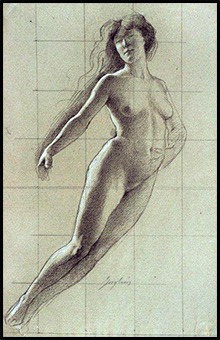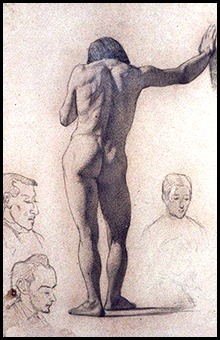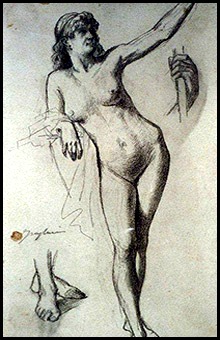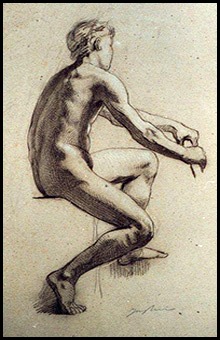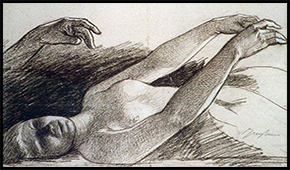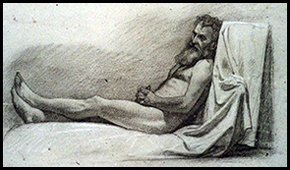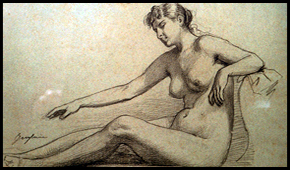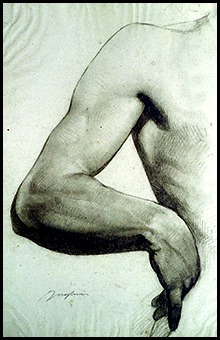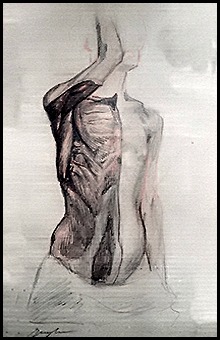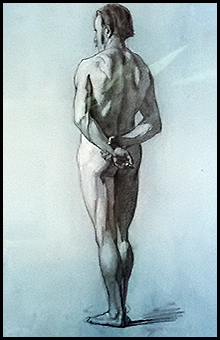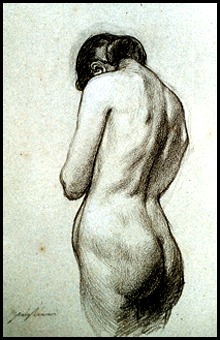

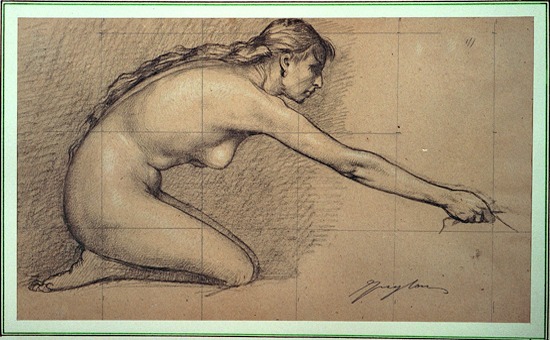
In his memoirs Tommaso Juglaris claims credit for introducing the public exhibition of the nude in art to Boston. The claim is not idle. Throughout the late nineteenth and early twentieth centuries any display of a nude figure in the United States was highly controversial, especially in the “Athens of America.”
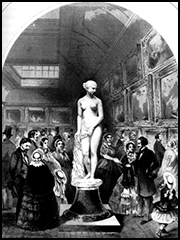
During the 1840s and 1850s the American sculptor Hiram Powers had successfully exhibited a nude, The Greek Slave, across the United States and Europe with huge crowds in attendance. As part of the tour, it was exhibited on the Boston Commons in 1848. The sculpted work depicts a full-figured woman, nude and bound in chains, with a small cross dangling from her hand, an emblem of her faith. Although The Greek Slave was considered provocative, Powers, helped by his publicist, was able to allay public outrage by crafting an elaborate and compelling moral narrative or story around his work. The naked woman was presented as a shining example of Christian moral purity transcending the degradation imposed upon her by Turkish captors, who were simultaneously waging a campaign to suppress a popular Greek independence movement. The story not only appealed to Boston’s church-going population but also abolitionists, proto-feminists, and advocates of Greek freedom. Beyond any thematic context, the fact that The Greek Slave was sculpted in cold white marble was also deemed significant: in the eyes of pundits and critics, it reduced the sensuality of the art work, making it morally palatable. A version of The Greek Slave were acquired by the Corcoran Gallery of Art in Washington, D.C., in 1851. Later, other copies found their way into American museums.
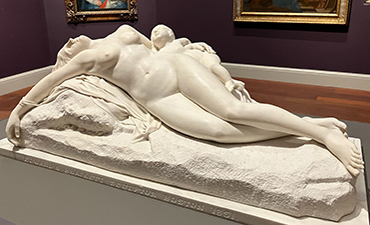
Inspired by the success of Powers’s Greek Slave, the self-taught Winchester, Massachusetts sculptor Edward Augustus Brackett unveiled in 1851 the creation of his own three years’ labor, Shipwrecked Mother and Child. Carved from a ton-and-a-half of white Vermont marble, it depicts a life-sized, drowned nude mother cradling her dead infant. The stanza of an accompanying narrative poem, The Wreck, offered explication: “While up the beach, beyond the reach / Of the restless, foaming tide, / Where the wreckage had been piled, / Without pulse, without breath, / Folded in the arms of death, / Lay the mother with her child.” For a half-century, until regifted and transferred to the Worcester Art Museum, the double sculpted marble portrait was kept on view in the Statuary Room of the Boston Athenaeum, a private library serving the city’s cultured elite. Two years after its initial unveiling, a Boston correspondent for the New York Times did take some umbrage with Brackett’s nude rendering. The critic pointedly noted that it was “not in harmony with our preconceived notions of statuary, derived from classic models,” adding that “Greek art would never have chosen such an idea.” Furthermore, the critic complained, “the figure seems too elaborately bare, where drapery might have been judiciously used; and the breasts are too round and well-shaped to be in exact harmony with the idea of such a catastrophe.” Nevertheless, the critic ultimately excused all this and any underlying concern about prurience, declaring that this nude “group of the ‘Mother and Child’ must be pronounced a rare and powerful achievement.” (New York Times, June 20, 1853, 2) The Athenaeum’s semi-private setting for Brackett’s nude sculpture certainly made its lingering presence in Boston more discreet. Yet its respectability was undoubtedly enhanced by association in the public imagination with the coincidentally tragic shipwreck deaths of the much-admired Massachusetts-born editor and journalist Margaret Fuller, along with her infant son and putative husband, on the coast of Fire Island, New York in July 1850.
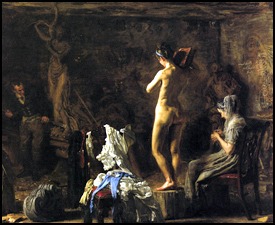
Another ground-breaking display of the nude form in American art came with the unveiling of a painting by the Philadelphia-based artist Thomas Eakins during the late 1870s. Entitled William Rush Carving His Allegorical Figure of the Schuylkill River, it depicts a naked female model, shown only from the rear, posing for the sculptor William Rush as he carves a statue meant to symbolize a river important to the prosperity of Philadelphia. While Eakins was bold in painting realistic light-dappled human flesh, he too embedded his work in a larger justifying narrative, presenting a historical scene of an earlier artist at work. However, he soon courted greater controversy when he painted Arcadia (1883) and Swimming (1885), depicting naked men and women bathing in classical or naturalistic settings. In 1886, Eakins was actually fired from his teaching post at the Pennsylvania Academy of Fine Arts after removing the loincloth from a nude male model during an anatomy lecture to female students. There was also an uproar over nude modeling among the Pennsylvania Academy’s female students. The scandal was greater than met the eye or was reported in print: a cache of photographs preserved from Eakins’s studio reveals that his own male and female students were modeling in mixed company and that he was participating as well.
The circumstances in Juglaris’s adopted city of Boston, famous for its Puritan heritage, remained perhaps even more tense than Philadelphia with regard to nude displays. While the exhibition of Powers’s Greek Slave and Brackett’s Shipwrecked Mother and Child might have served as ice-breakers, anything overtly and unduly sensual in art was still decades later destined for a frosty reception, if not attempted outright ban.

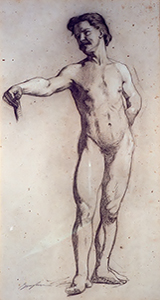
In 1876, as the Boston Museum of Fine Arts prepared to open its doors, the new institution’s trustees felt obliged to add fig leaves to the plaster casts of classical statuary adorning their galleries. Four years later, with the Museum’s School for Drawing and Painting also well underway, art students interested in a “life class” that would allow them to paint more than a head of a model found themselves stymied: William Ware, secretary of the school and a dean at the Massachusetts Institute of Technology, informed them that “the horror of some of the Trustees at the idea of a nude model in their chaste Museum of Fine Arts was too great to be overcome.” However, during the school year 1880-81, Ernest Longfellow, the son of the famous poet whom Juglaris had known as part of Thomas Couture’s circle in France, finally received permission from museum trustees to lead a class in drawing from the nude. “As school historian Winthrop Pierce recalls, cited by Walter Muir Whitehall in Museum of Fine Arts: A Centennial History, Longfellow’s “permission…was strictly limited to the male nude.” Moreover, the “cost of the model was shared by the class. Those who availed themselves of this chance to study the figure met on certain afternoons with a carefully locked doors, to enjoy the sense of being in opposition to their elders, always so dear to youth. [Walter Muir Whitehill, Museum of Fine Arts: A Centennial History, Cambridge, Massachusetts: Belknap Press/Harvard University Press, 53]
The students’s classroom experience whetted their appetite for greater freedom in studying and displaying the human nude. After the William and Everett Glery of Boston exhibited in 1883 a full frontal male nude by the French artist George Henri Regnault, Audomedon and the Horses of Achilles, and Boston Museum of Fine Arts accepted it from its St. Louis owner Samuel Coale on extended loan, Museum School students initiated what became a successful five year campaign for the painting’s purchase which, culminating in 1890, was funded by their own subscriptions. However, even in the case of male nudes, controversy over any public display was not done. Boston sensitivities were aroused anew with much consternation generated when an 1885 Boston Art Club show mounted by the Society of Amateur Photographers (subsequently known as the Boston Camera Club) included images of several artistically posed nude men.
Juglaris arrived in Boston at a cultural tipping point. Amazed by the prudery that he encountered in America and, more particularly, Boston, he took outright pride in being at the forefront of artists of making the presentation of male and female nudes acceptable and commonplace in publicly displayed art, starting with November1880 exhibition of his Paris Salon painting, The Invasion. Boston Museum curators hung the painting high over a doorway. But the nudity the Invasion’s male and female figures could not be obscured, incurring the ire of Boston’s moral arbiters. As Juglaris remarks in his memoirs, claiming only a little more credit than he might deserve: “The papers spoke very well of my works, in fact far better than I would have thought they would, as I was a foreigner. However, harsh observations were made insofar as the exposed nudity was concerned… I was in fact the first to have risked exhibiting nude figures in America, in Boston in particular. I had removed the veil of chastity and purity from Puritanism. They forgave me because I was a foreigner, but hard things were said to the [organizing] committee and the [museum’s] administration.” In the ensuing decade, Juglaris continued to exhibit drawings from the nude at subsequent Boston exhibitions.

Ironically, it was Juglaris’s talent for drawing from a nude or semi-nude live model that won him the coveted position as teacher-in-residence at the Boston Art Club in 1882. As Juglaris’s memoirs recount, he personally suggested to the Boston Art Club search committee the very parameters of a competition for the open instructional post. Consequently, per much of his own recommendation, he was invited along with seventeen other eager “contestants” to “do a large life-size drawing [of a live male model with only naked torso exposed] indicating first of all the action of the bones, then the movement of the principal muscles and lastly, finish it with charcoal in the space of ten or twelve hours.” Thanks to his significant studies of human anatomy at Turin’s Albertina Academy, his Italian apprenticeship with Paoli Morgari, and his Beaux Arts training with Gerome, Cabanel, and Couture in France, Juglaris handily won the full-day contest with most, if not all, of the other candidates dropping away, daunted by their assigned task.
That same year the Boston Art Club was constructing a handsome new facility on Newberry Street in the city’s Back Bay neighborhood. Juglaris advised the Club’s trustees and architect on the appropriate design of an amphitheater for life drawing classes, based on his own experiences with art schools and “theaters of the nude” in Europe. Thereafter, hired by the Boston Art Club to serve as a resident instructor, Juglaris brought his more cosmopolitan European perspective on the nude to evening classes taught in the new amphitheater. As reflected in his own portfolio, Juglaris believed that studies from the nude were foundational for learning how to skillfully draw any human figure, whether dressed or undressed.
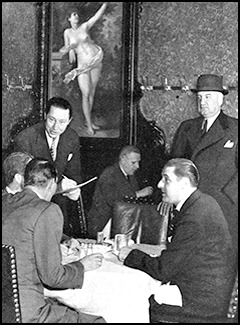
As a “nude debate” contemporaneously raged across the Atlantic in London and Boston was freshly roiled by yet another controversy precipitated by a Boston Art Club exhibition (1885) of male nude photographs curated by the Boston Camera Club (also known as the Society of Amateur Photographers), Juglaris put his own talent for the nude further on conspicuous public display. In 1885-1886, the new Locke-Ober’s Restaurant at 2 Winter Place, a half-block from the Boston Commons, commissioned Juglaris to paint in oil the commanding nude work, Mlle. Yvonne. A frontal nude, the handsome full-figured “Yvonne” leans on a classical-style post in a garden setting. She looks up to her own upraised hand holding a chalice that resembles a large champagne glass, perhaps toasting or celebrating life.There is no larger or deeper narrative to rationalize or justify her nudity. Adorning the popular Men’s Bar of the Locke-Ober Restaurant, Mlle. Yvonne was part of a wave of similar “saloon nudes” by other artists, including Jules Lefebvre, Adolphe Bouguereau, and John Noble mounted in places where men more exclusively gathered and socialized.
Juglaris’s painting at Locke-Ober’s served as a Boston landmark for next century and more. Legends grew up that Juglaris had painted the statuesque figure in a nearby garret and then sold the painting to Locke-Ober’s for a handful of dollars to avoid starvation. As late as the 1940s, Mlle. Yvonne was the topic of commentary in the Boston Sunday Herald where Juglaris, by then mostly forgotten in Boston, was described as an artist “with a flair for painting that is stunningly apparent.” In the 1980s and 1990s, Mlle. Yvonne became the focus of an informal men’s club among diners at Locke-Ober’s: members were issued fancy red suspenders displaying her image. At some point, it became customary to drape the frame of Mlle. Yvonne in black crepe whenever Harvard University’s football team lost a game to archrival Yale.
When Locke-Ober’s closed in 2012, all of historic restaurant’s contents were sold at auction, except for the Juglaris painting, which was retained by its owner. However, Mlle. Yvonne has since inspired a new restaurant, Yvonne’s, in the former Locke-Ober location. The contemporary Dutch artist Handiedan was commissioned to paint a fresh version of Juglaris’s nude lady. It is now enshrined in the new Boston supper club which opened in September 2015.
Juglaris’s best efforts notwithstanding, Boston continued to have reservations about nude displays in art even a full decade afterMlle. Yvonne was first installed. Controversy erupted over at least two sculptural pieces—the first by Augustus Saint Gaudens; the second by Frederick MacMonnies.
The controversial piece by Augustus Saint-Gaudens was a sculpted “devise” intended to serve as a symbol for the Boston Public Library. It presented two nude boys, each bearing torches of learning, and supporting a shield with the library’s founding dates and Latin motto. As historian Walter Muir Whitehall notes, it provoked a great hue and cry:
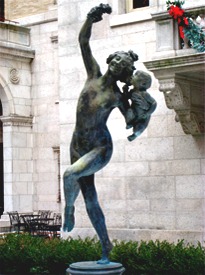
“This pleasant composition, although of the most idyllic and high-minded nature, was presently denounced in 1894 by newspaper reports as a major indecency, because of the nakedness of the small boys. The Boston Evening Record crusaded for fig leaves or chisels, even going to far as to denounce the entire building (not yet open to the public) as a ‘stench and an eye-sore’; this flaunting of virtue was too ridiculous to succeed even in Boston.” [Walter Muir Whitehall, “The Making of an Architectural masterpiece—The Boston Public Library, American Art Journal 2 (Autumn): 28 (quote); also see Whitehead, “The Vicissitudes of Bacchante in Boston,” New England Quarterly 27 (December 1954): 435-454]
Subsequently, the controversy did abate with the “little boys neither clothed nor castrated.” Perhaps, briefly, it even looked as if a page had definitely been turned in Boston. In 1895-1896, the acclaimed French muralist Pierre Puvis de Chavannes completed a series of murals for the grand staircase and loggia of the new Boston Public Library on Copley Square. Two of the panels, symbolically representing Chemistry and History, feature nude figures. They were mounted on the walls without public protest. However, that very same year (1896) the library’s architect, Harvard-educated Charles Follen McKim, faced another firestorm when he offered to the library trustees the gift of a nude Frederick MacMonnies statue, Bacchante and Infant Faun. It was meant to adorn a courtyard fountain as a memorial to his own late wife, a member of Boston’s famous Appleton family. Although actually installed in the library’s classical, open-air courtyard, the sculpture had to be removed six months later due to vocal public opposition. McKim donated it to the Metropolitan Museum of Art in New York City instead.
Undeterred by the previous controversy at the Boston Public Library which had occurred in his absence, Juglaris made the nude form a an integral part of his enormous Grecian Festival mural cycle at the Franklin Public Library when he returned to the United States from Italy during summers from 1902 to 1904. At the center of his library mural is a swirl of lithe and ecstatic semi-nude dancers. Likewise, a series of high-wall friezes in the nearby entrance hall also painted by Juglaris display no shortage of female bosom. Likewise, despite archival photos that show that Juglaris revised many of the Grecian Festival panels for the main reading room before final installation and unveiling to reduce or eliminate nudity, many of his figures remain conspicuously exposed. For the past century they have been casually viewed every day by library patrons of all ages. Ultimately, Juglaris, like Puvis de Chavannes, enjoyed an artistic victory that eluded McKim’s efforts to make MacMonnies’s Bacchante and Infant Faun a focal point of the Boston Public Library courtyard.
During his decade in Boston Juglaris’s role in introducing the nude was underscored at a dinner hosted by his friends and students honoring him: each banquet table was decorated with an emblematic nude image. Today, though Juglaris’s name may no longer be familiar to Bostonians and the original splendor of Mlle. Yvonne has disappeared from public sight, his contributions to the nude in art can still be appreciated by those touring the Franklin Public Library or taking a glance at the drawings from his own hand which survive.
